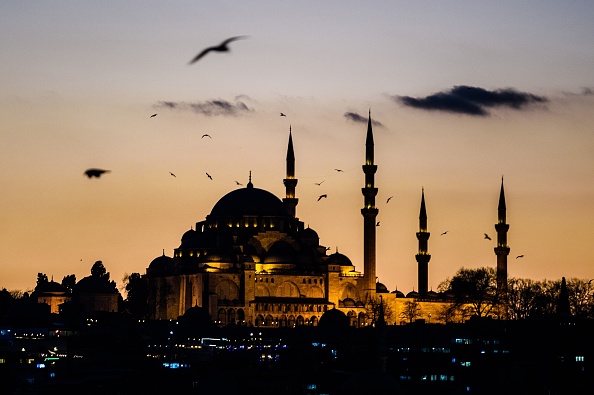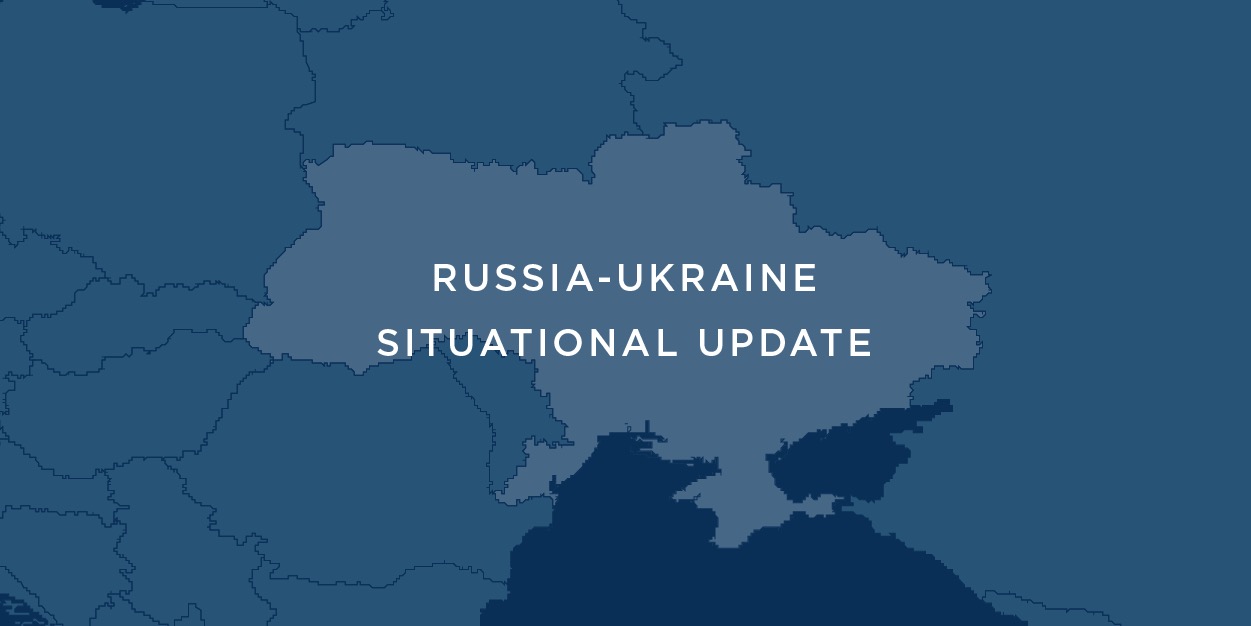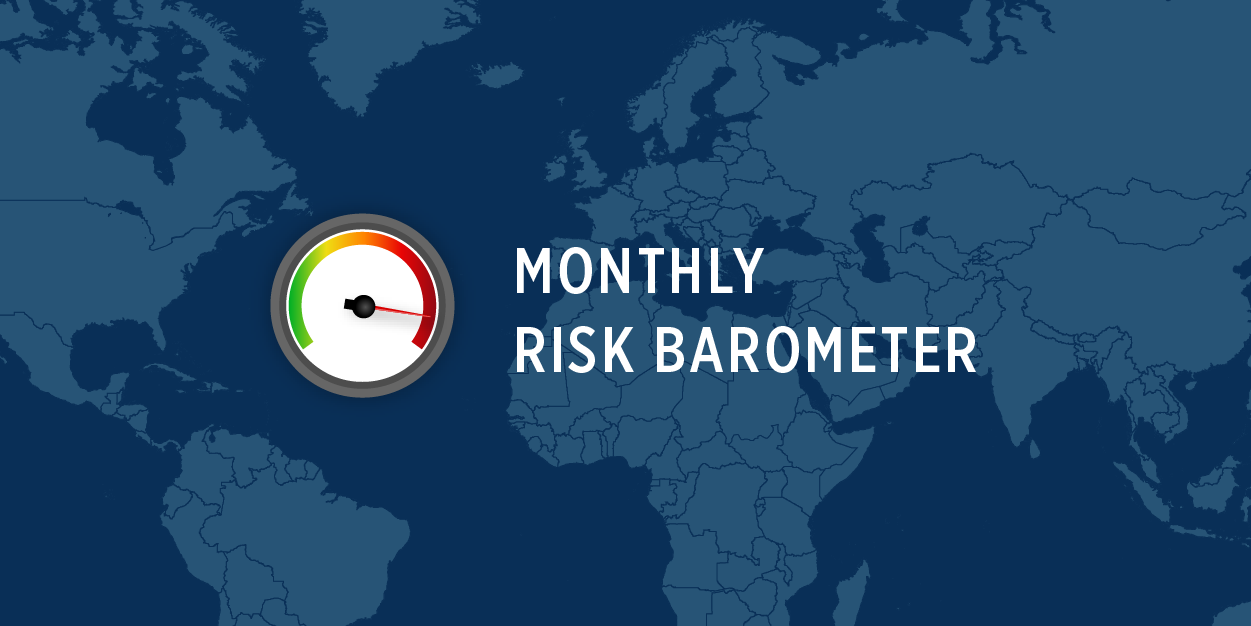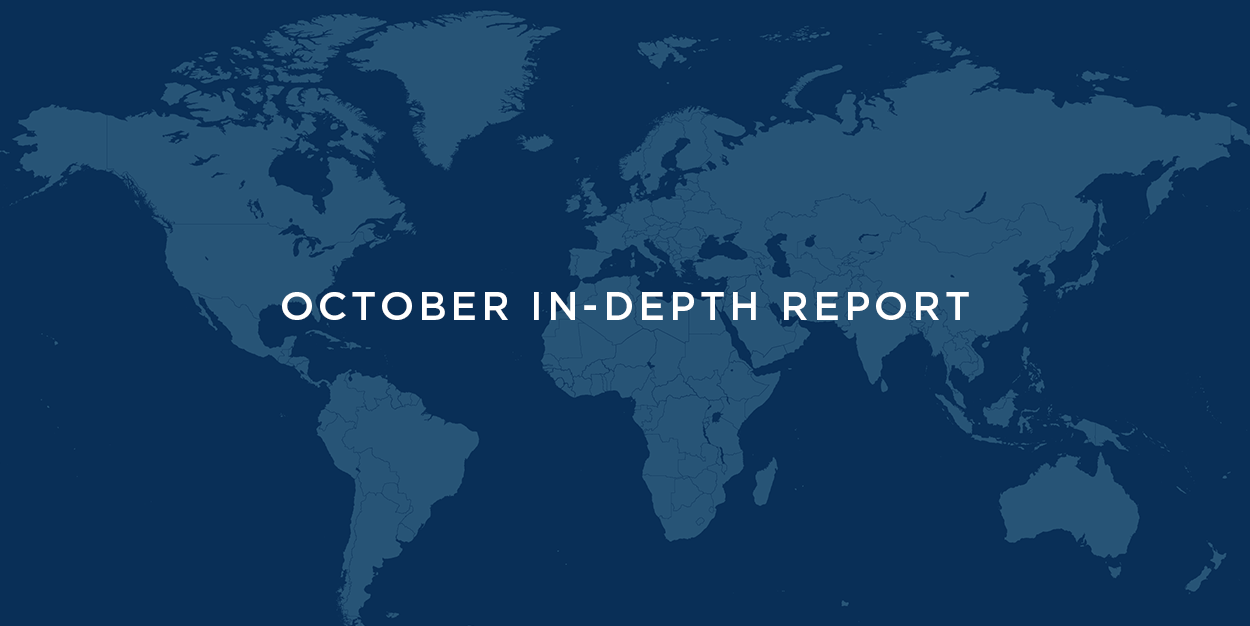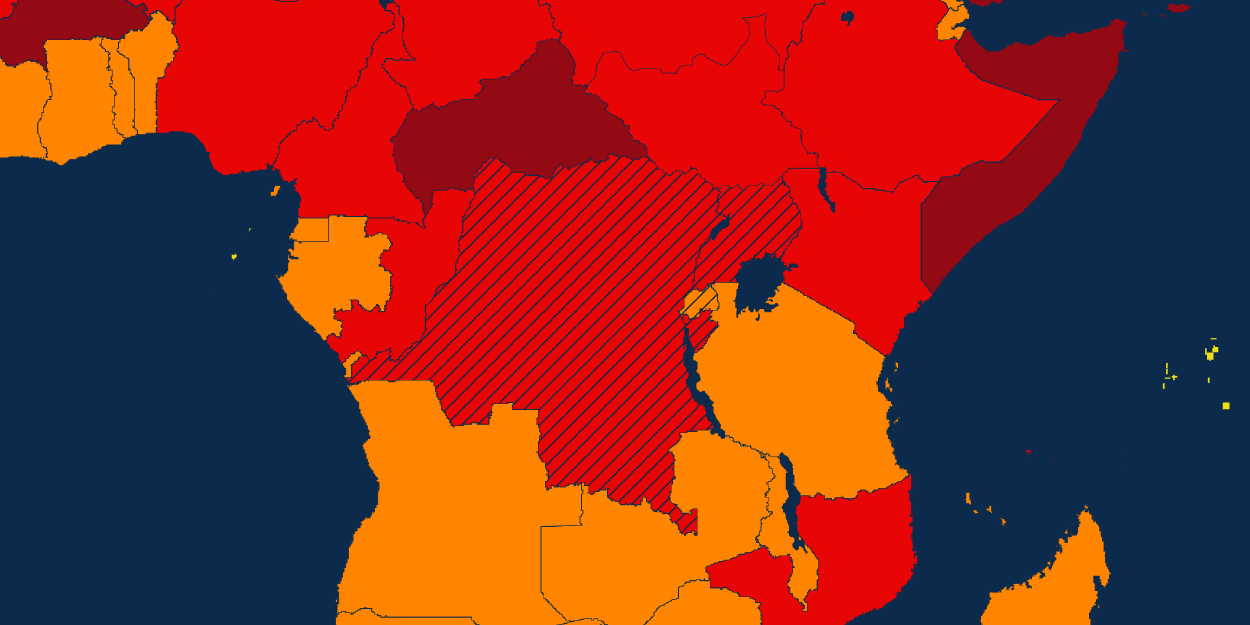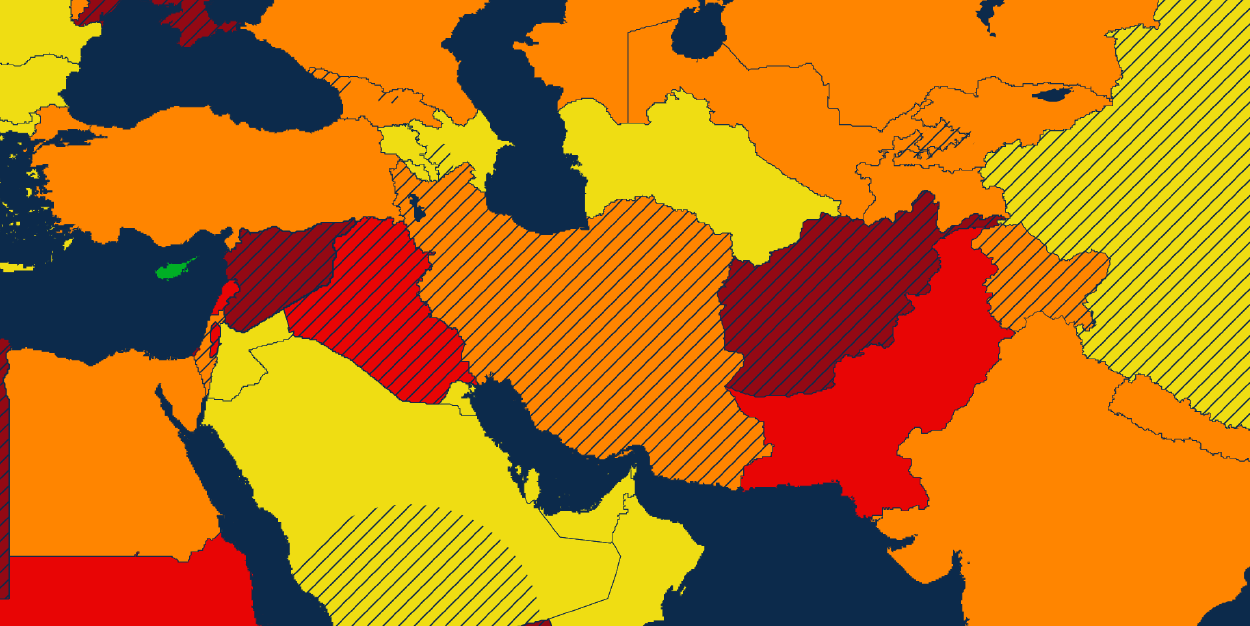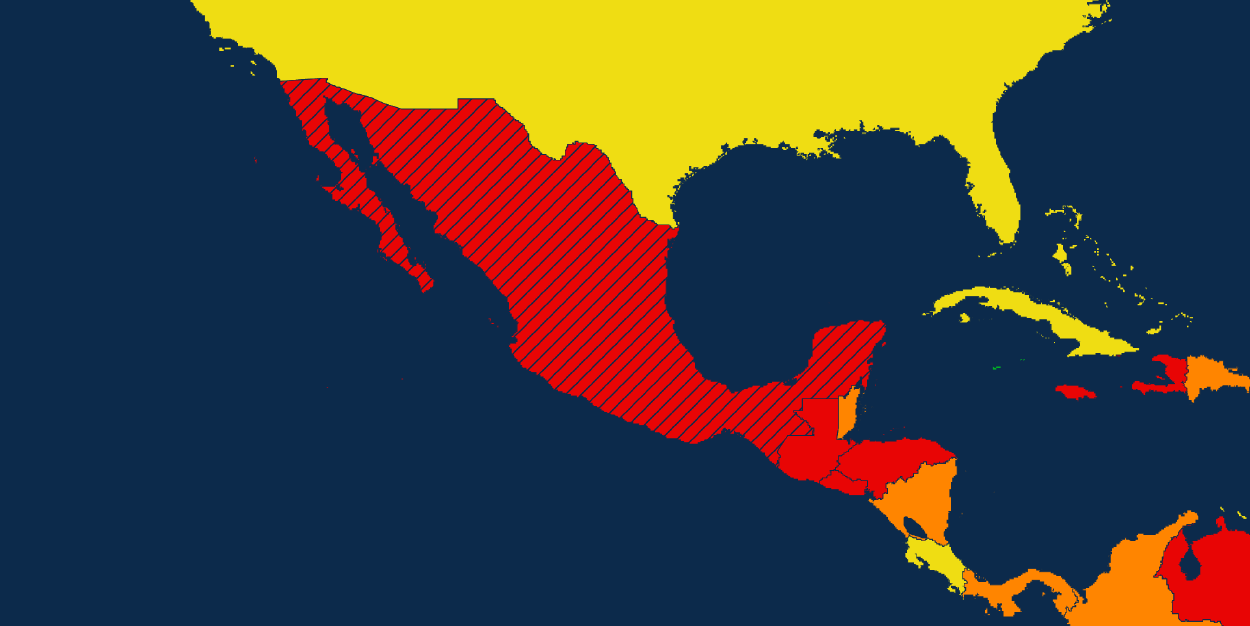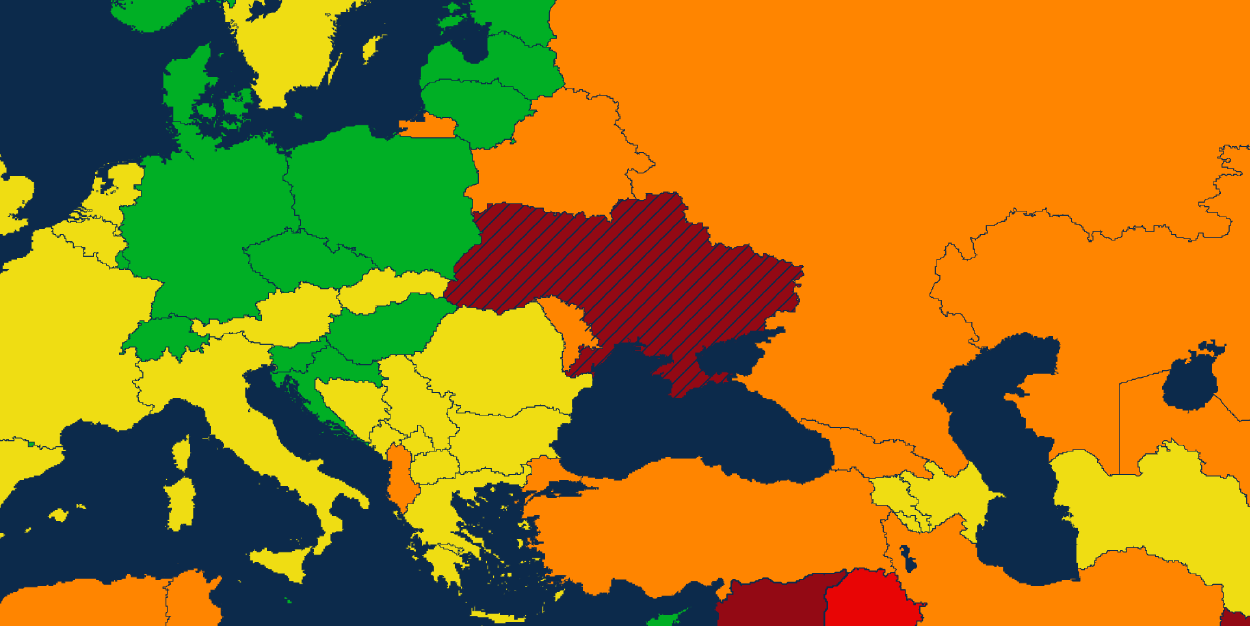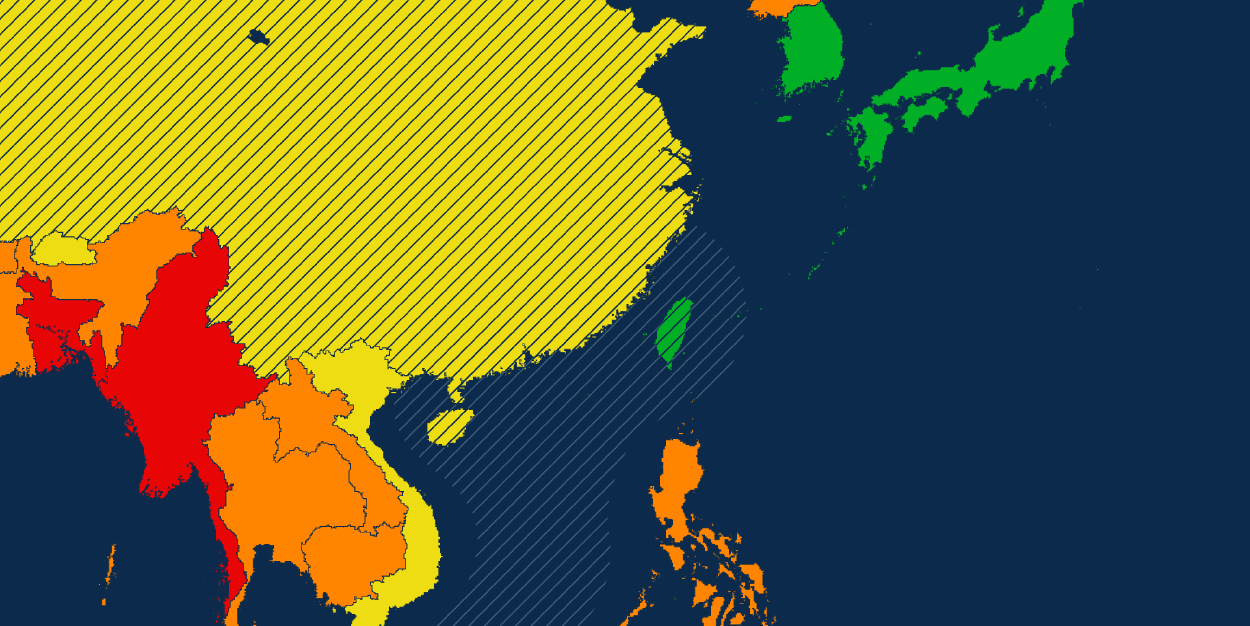In Global Guardian's monthly Risk Barometer, our Intelligence Team highlights current global hotspots with the potential to impact your business operations and travels. Read below for analysis on the threats we are closely monitoring this month and click here to subscribe for regular intelligence updates, including this monthly report.
Europe Prepares for Cold, Expensive Winter as Discontent Mounts
The loss of cheap Russian gas and the failure to quickly source sufficient alternatives has caused heating bills to skyrocket across the continent, contributing to record inflation. The rising cost of energy on the continent has pushed inflation into the double digits in half the Eurozone countries. The cost-of-living crisis has escalated into protests in recent months as winter approaches and Europeans feel the economic pressure stemming from the war in Ukraine.
Soaring Inflation
In Germany, inflation has risen to 11.6%, in the Netherlands to 16.8%, and in the Baltic countries where inflation is highest in the Eurozone, the rate is hovering above 21%. The bloc as a whole hit a record high in October at 10.6%. Rising costs are hitting consumers hard. By mid-September energy costs in Britain had risen to $532 per megawatt-hour, resulting in annual bills in the range of $1600, up nearly $1000 from the annual price in August.
| Inflation Rates by Country in Europe |
Average Monthly Electricity Wholesale Prices in Selected Countries in the EU from January 2020 to September 2022 (in Euros per megawatt-hour) |
|
|
| Source: Trading Economics, Eurostat |
Source: Statista |
How We Got Here
- 27 April – Russian gas giant, Gazprom stopped supplying gas to Bulgaria and Poland after the countries missed the deadline to start payment in Russian currency.
- 30 May – The EU imposed a partial ban on imports of Russian crude oil and total ban on imports of Russian coal.
- 31 May – Gazprom stopped supplying certain energy companies, including Gasterra (Dutch) and Orsted (Danish).
- 16 June – Russia throttled Nord Stream I to 40% capacity.
- 26 September – The Nord Stream pipelines were sabotaged, cutting off natural gas supplies running from Russia through the Baltic to Germany.
- 05 October – OPEC announced an oil production cut citing a supply surplus.
Inflation had been rising globally since the beginning of the COVID-19 crisis due to the whiplash lockdowns placed on supply chains and synchronous highly expansionary fiscal policy across much of the globe. But the recent explosion in prices is mostly attributable to Russia’s implementation of an energy embargo in response to EU sanctions over the former’s invasion of Ukraine. Prior to the invasion, imports from Russia accounted for roughly 40% of European gas consumption which in turn accounted for more than a third of European energy production. Germany, Europe’s largest economy, relied on Russia for 55% of its gas supply. The Russian throttling of the energy supply is incurring significant economic and political costs.
Implications
Discontent has escalated into protests in recent months as winter approaches and Europeans feel the economic pressure of supporting Ukraine. Demonstrations in Czechia, Germany, and France have drawn crowds numbering in the thousands.
Czechia
- Thousands of protesters have filled Prague’s Wenceslas Square in a series of anti-government protests over the past several weeks. The protesters are calling for the resignation of the current center-right Czech government and for a new gas deal with Russia. The crowd comprised members of the far-right Freedom and Direct Democracy Party as well as communists, and a substantial number of unaffiliated but disgruntled Czechs.
- On 28 September, more than 70,000 protesters demonstrated in Prague.
Germany
- Tens of thousands of Germans in six cities protested on 22 October, calling for a more equitable distribution of government assistance following a 65 billion Euro relief package.
France
- More than 100,000 people protested across the country, with more than 10,000 in Paris alone, as striking refinery workers were joined by members of the education, transport, health, and other sectors calling for higher wages in the face of steep price increases.
- Roughly 28% of gas stations in France have run out of gasoline or diesel fuel.
Looking Forward
Russia has already cut roughly 88% of the gas it supplies to Europe. Further cuts would disproportionately affect Eastern European countries, particularly Hungary and Bulgaria. Europe is now scrambling for new sources of gas. The Baltic Pipeline, running from Norway to Poland, opened in early October. Bulgaria is set to begin importing Azeri natural gas via Greece later this year. The bloc has increased imports of liquified natural gas (LNG) by nearly 50% compared to 2021 mostly from the United States and Asia. But due to a lack of LNG regasification facilities, and a habitual industrial reliance on low Russian prices, the economic shock Europe is currently experiencing will be difficult to mitigate. Between countries with strong collective action – countries with powerful unions and robust manufacturing sectors – and those with highly politically polarized populations, a winter of discontent looms across much of Europe.
KEY TAKEAWAYS The combination of European sanctions on Russia and Russian energy throttling is contributing to record inflation and a simultaneous reduction in productive output in Europe. These twin economic issues are exacerbating existing fault lines between people and their governments as well as between nations and the EU. Depending on the severity of this winter, the stress may be significant enough to prompt substantial unrest. |
Protests Near Inflection Point as Violence Increases
The current protest movement in Iran poses the greatest threat to the ruling regime since the 2009 Green Movement, though major cracks in the state have yet to appear. The protests, now into their seventh week, are nearing an inflection point, as the regime doubles down on its violent repression to quash the protests. But absent of a more coordinated approach or the defection of members of the security apparatus, the movement is unlikely to bring about profound change. Internationally, the violence has spilled over into Iraqi Kurdistan, solidarity demonstrations have occurred across the globe, and reports have emerged over potential Iranian attacks on Saudi oil infrastructure.
On 16 September, a 22-year-old Kurdish-Iranian women, Mahsa Amini, died in police custody after allegedly being beaten in detention following her arrest for violating Iran’s Islamic dress code for women. While protests began as a women-led movement demonstrating against social restrictions and against the repression of the Kurdish community, the grassroots movement has expanded to call for the toppling of the regime. Widespread protests have erupted in over 200 municipalities, at schools, universities, outside of government buildings, and in city centers, often turning violent with security forces using heavy-handed tactics, including the use of water cannons, tear gas, and live ammunition to disperse protesters. So far, at least 280 individuals have been killed and over 14,000 demonstrators have been arrested.
Notable Developments
- Security forces have been reported arresting students at universities in Tehran, Mashhad, and Arak.
- The government has limited internet connectivity across the country.
- Warehouses have allegedly been converted to house political prisoners.
- 28 September – 03 October, Iran launched punitive cross-border rocket, drone, and artillery strikes in Iraq’s Erbil province targeting Kurdish separatist groups. Dozen people were killed, including an American citizen in these attacks.
- On 15 October, intense clashes broke out between prisoners and guards at the Evin Prison in Tehran, which houses many political prisoners.
- On 01 November, Saudi Arabia shared intelligence of a possible Iranian attack on its energy infrastructure.
- On 03 November, Germany advised its citizens to immediately leave Iran and avoid all travel to the country due to the risk of arbitrary arrest.
Avoid all non-essential travel to Iran and Erbil, Iraq. Use Global Guardian’s mobile app to avoid demonstration-related traffic delays in cities with Iran solidarity protests.
Analysis
Iran, despite the presence of pseudo-democratic governance, is a religious oligarchy where power lies with the state bureaucracy, and religious and military elites. The country has no civil society, making protest the only way to channel frustrations against the state. Conversely, in such a brittle regime, grassroots protests pose the greatest threat to the Islamic Republic. While we have seen protests surrounding elections and economic and ethnic grievances over the last two decades, the current protest movement has spread across all strata of society and has penetrated highly conservative, pro-regime strongholds, including Qom and Mashad. What’s more, the protests are no longer issue-based. Disparate elements in society, led by women and students, are calling for political change. A leaked government report suggest that protesters are increasingly willing to risk arrest, and possibly death, to incite change. But the Iranian regime has extensive experience snuffing out dissent. For the protests to achieve any real political change, members of the security apparatus will need to start to refuse orders or defect.
Regime Gears for More Violent Suppression
The chief justices of Tehran and Shriaz provinces have announced that they will make the protester trials public, indicating that these will likely be show trials with harsh sentencing to make examples out of the defendants. Meanwhile, on 30 October, parliament passed a bill to increase the salaries of security forces by 20 percent, a move to prevent defection. These actions combined with the increasingly harsh rhetoric signal that the regime is likely to double down on its repressive policies. But the more protesters that are killed, the more opportunities that will arise for protests. Funeral marches occur 40 days after these deaths and have been galvanizing the protests.
Looking Ahead
The situation in Iran can go one of two ways. Either the regime continues its current approach, or it eases off and the protests enter a steady state of low-medium intensity such that few protesters are martyred. The longer the high levels of state violence persist, the more likely parts of the security establishment crack. On the international stage, looking weak both at home and abroad, Iran is unlikely to make any concessions or take any actions to further the diplomatic attempt to revive to 2015 nuclear agreement. In addition, there is a likelihood that Iran lashes out at its enemies in the region. This could include further attacks on Kurdish militant groups in Iraq, Saudi oil infrastructure, international shipping in the Gulf, or Israel. In the long-run, the state violence directed against high-school and university students will help poison the next generation against the regime.
Key Takeaways The situation will continue to deteriorate, as protests grow, and the regime increases its violent repression. Unless key members of the country’s security apparatus begin to defect, it is unlikely that the Islamic Republic will fall. In the short term, the deaths of security forces and other mass casualty events in Iran may lead Iran to lash out at its regional rivals to preserve its strong image. In the long run, this protest movement may sow the seeds of the regime’s collapse as the security crackdown is alienating large swathes of Iran’s under-30 demographic who comprise over 60 percent of the population. |
Security Situation in HAITI Continues to Deteriorate
Social unrest and gang violence in Haiti have spiked in recent weeks, prompting Prime Minister Ariel Henry to appeal to the international community for security assistance. Violence has expanded from the periphery of the Cité Soleil neighborhood to formerly safe suburbs in the north and gangs now control the flow of food, medicines, and energy. The Department of State has now warned U.S. citizens to depart the country. Travel in and around the capital should only be undertaken with extreme caution, preferably utilizing secure transportation during daylight hours.
Current State
Henry’s request comes a month after planned cuts to fuel subsidies amid an economic crisis unleashed a torrent of unrest across Haiti. Protesters are demanding the resignation of Henry, who has been implicated in the 2021 assassination of President Jovenel Moïse and has failed to hold fresh parliamentary elections. Henry was neither elected nor confirmed by the legislature, and his legitimacy is often cause for unrest.
The rising insecurity has led to a proliferation of gang activity. The most powerful federation of gangs is G9, led by a former police officer. It controls large swathes of the capital, including some port areas where food and fuel shipments arrive, forcing politicians and businesspeople alike to strike deals to keep goods flowing. Gangs recently stormed a key fuel terminal in the capital, preventing the distribution of millions of gallons of gas, and have also looted food aid centers. As a result, hospitals and schools have been forced to close, reinforcing civil instability, and prompting additional social unrest.
Gang Violence Snapshot
- In the period from January – September 2022:
- 994 Homicides
- 700 Kidnappings
- Number of Haitian street gangs in 2021: 80
- Number of Haitian street gangs in 2022: 150 (92 in Port-au-Prince alone)
- Recent violence has centered around the Cité Soleil neighborhood where G-Pèp and G9 have battled for control
- Violence has expanded from the periphery of the Cité Soleil neighborhood to formerly safe suburbs in the north
- On 28 October, suspected gang members assassinated Haitian politician Eric-Jean Baptiste while he was traveling to his residence located in the Laboule 12 area of the capital Port-au-Prince.
Cité Soleil, Bel-Air, and the surrounding areas are deemed “no-go zones,” and should be avoided at all costs. Non-essential travel to Haiti should be avoided. Mission-critical travel should only be undertaken with a full security detail, following careful route assessments and reconnaissance.
Context
Haiti—the poorest country in the Western Hemisphere—is a failed state, marred by near-constant violent social upheaval, corruption, and extreme gang violence. The situation on the ground has severely deteriorated over the last two years, and especially since the assassination of President Jovenel Moise and massive prison break in 2021. With less than 13,000 officers, the police are significantly outnumbered. Gangs have become the primary stakeholders in Haiti with ties to political and security elements.
Without outside assistance, the structural issues in Haiti appear insurmountable. But International security assistance is unlikely, given how the United Nations mission left the country shamed in 2017 after spreading cholera and being accused of widespread sexual violence. Haitians do not want foreigners intervening in their affairs again. Meanwhile, in the U.S., there is little interest in foreign intervention, especially given the ongoing war in Ukraine and potential for conflict around China-Taiwan. Global economic concerns also weigh heavily on any chances of international intervention.
Implications
In light of the deteriorating security situation, the U.S. State Department issued an updated Travel Advisory on 07 October authorizing the departure of non-emergency U.S. government personnel and eligible family members. In addition, the advisory states that “U.S. citizens should depart Haiti now in light of the current security and health situation and infrastructure challenges.”
While the international airport remains operational, roads in and out of the airport are falling more and more under gang control and leaving or entering the country gets riskier each day. Additionally, roadblocks of burning tires and vehicles caused by protests can often hinder access to the airport or other parts of the city.
KEY TAKEAWAYS There is no relief in sight for Haiti. Gangs have taken over more and more control of access to and distribution of food and fuel. As long as this remains true, intergovernmental organizations and international NGOs will be less likely to send aid. This creates a vicious cycle of corruption and increased gang influence, leading to more social unrest. Five years after the departure of UN forces, security intervention, again, appears to be the only practical solution, yet there is little political will internationally. |
Terror Warnings Issued for Abuja
The terror threat level in Nigeria’s capital, Abuja has increased. The overall security situation in Nigeria has been precipitously declining after a brazen and unprecedented jailbreak operation on 05 July, when Islamic State West Africa Province (ISWAP) jihadists raided a prison in the Kuje area of the Federal Capital Territory (FCT), freeing 69 jailed group members along with over 700 others. Recently, the U.S., UK, Canada, Australia, and Israel have issued travel advisories highlighting the possibility of a terror attack in Abuja.
On 23 October, the U.S. Embassy Abuja disseminated a security alert, highlighting an elevated risk of terror attacks in the capital. Several other nations issued similar warnings and the Department of State subsequently ordered the departure of family members of U.S. government employees from Abuja on 27 October. The alerts warned of possible attacks on public places, including government buildings, shopping malls, hotels, social and athletic gatherings, international organizations, and transport hub.
According to security sources, many jihadists have blended into the civilian population in the FCT and have been planning attacks. In recent weeks, several high-profile ISWAP members have been arrested near the capital and security raids are occurring on a near-daily basis. Following the embassy-issued alerts, extra security measures have been reported at Nnamdi Azikiwe International Airport (ABV), religious buildings, and in the city center.
- Foreigners are the highest value targets for Salafist jihadi groups, including ISWAP.
- Global Guardian recommends against non-essential travel to Nigeria.
- Ahead of any essential travel to Nigeria, monitoring the security situation in Nigeria and pre-trip intelligence is recommended.
Analysis
Abuja was once considered immune from the impacts of the jihadist threat, but this is no longer the case. Despite the Nigerian military’s gains against jihadist militants in northeastern Nigeria, ISWAP has expanded into central and even southern Nigeria, having claimed its first ever attack in Ondo State on 22 September. ISWAP is desperate to take the pressure off its strongholds and change the conversation. At a time where international terrorism has taken a backseat to the war in Ukraine, the Islamic State as an international brand is stiving to return to relevance. Major, attention-grabbing attacks are critical for fundraising, morale, and recruitment.
Looking Forward
Between the deteriorating security situation—daily jihadist and ethnic militia (Fulani militants) attacks, with an increase in kidnappings—and rising inflation, Nigeria is reaching a boiling point less than four months ahead of its next general election. The stakes are high for both the sitting government and for ISWAP to execute their cross-purposing missions. It may be possible that Nigerian security forces have disrupted several recent plots and it is likely that Nigerian forward pressure is complicating ISWAP’s plans. That said, it is ISWAP’s modus operandi to spring its fighters from prison before launching a series of high-profile attacks.
KEY TAKEAWAYS The security environment in central Nigeria and within the capital region has been in a precipitous decline since the 05 July ISWP jailbreak. Despite counter-terror efforts, jihadist elements are purported to be planning attacks on Abuja, prompting the U.S. and several other countries to issue travel warnings. In the lead up to the February 2023, we expect to see both an increase the terror activity and political violence. |

